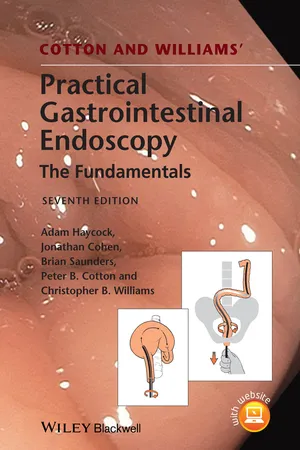
Cotton and Williams' Practical Gastrointestinal Endoscopy
The Fundamentals
- English
- ePUB (mobile friendly)
- Available on iOS & Android
Cotton and Williams' Practical Gastrointestinal Endoscopy
The Fundamentals
About this book
Translated into seven languages, Cotton and Williams' Practical Gastrointestinal Endoscopy has for the last 25 years been the basic primer for endoscopy around the world, providing clear, clinical and practical guidance on the fundamentals of endoscopy practice, from patient positioning and safety, how to perform different endoscopic procedures, and the latest in therapeutic techniques and advances in technology.
It's key strength and reason for its popularity is its step-by-step, practical approach, especially with the use of outstanding colour artwork to illustrate the right and wrong ways to perform endoscopy. Add to this the weight and expertise of its author team, led by Peter Cotton and Christopher Williams, and the final result is an essential tool for all gastroenterologists and endoscopists, particularly trainees looking to improve their endoscopic technique.
Joining Peter Cotton, Christopher Williams and Brian Saunders in the seventh edition are two exciting stars in UK and US endoscopy, Adam Haycock and Jonathan Cohen. New to this edition are:
- Approximately 35 high-quality videos illustrating optimum endoscopy practice, all referenced via "video eyes" in the text
- Self-assessment MCQs to test main learning points
- An online clinical photo imagebank to complement the line illustrations, perfect for downloading into scientific presentations
- Key learning points in every chapter
- Much more information on mucosal resection techniques and small bowel endoscopy—for capsule and "deep" enteroscopy
- The latest recommendations and guidelines from the ASGE, ASG, UEGW and BSG.
Cotton and Williams' Practical Gastrointestinal Endoscopy, seventh edition is fully modernised, masterful as ever, and once again, the number one endoscopy manual for a whole new generation of gastroenterologists and endoscopists.
Frequently asked questions
- Essential is ideal for learners and professionals who enjoy exploring a wide range of subjects. Access the Essential Library with 800,000+ trusted titles and best-sellers across business, personal growth, and the humanities. Includes unlimited reading time and Standard Read Aloud voice.
- Complete: Perfect for advanced learners and researchers needing full, unrestricted access. Unlock 1.4M+ books across hundreds of subjects, including academic and specialized titles. The Complete Plan also includes advanced features like Premium Read Aloud and Research Assistant.
Please note we cannot support devices running on iOS 13 and Android 7 or earlier. Learn more about using the app.
Information

Endoscopy units
Procedure rooms
- not be cluttered or intimidating. Most patients are not sedated when they enter, so it is better for the room to resemble a modern dental office, or kitchen, rather than an operating room.
- be large enough to allow a patient stretcher/trolley to be rotated on its axis, and to accommodate all of the equipment and staff (and any emergency team), but also compact enough for efficient function.
- be laid out with function in mind, keeping nursing and doctor spheres of activity separate (Fig 1.1), and minimizing exposed trailing electrical cables and pipes (best by ceiling-mounted beams).

- piped oxygen and suction (two lines);
- lighting planned to illuminate nursing activities but not dazzle the patient or endoscopist;
- video monitors placed conveniently for the endoscopist and assistants, but also allowing the patient to view, if wished;
- adequate counter space for accessories, with a large sink or receptacle for dirty equipment;
- storage space for equipment required on a daily basis;
- systems of communication with the charge nurse desk, and emergency call;
- disposal systems for hazardous materials.
Patient preparation and recovery areas
Equipment management and storage
Staff
- prepare patients for their procedures, physically and mentally;
- set up all necessary equipment;
- assist endoscopists during procedures;
- monitor patients' safety, sedation, and recovery;
- clean, disinfect, and process equipment;
- maintain quality control.
Procedure reports
Nurse's report
Endoscopist's report
The paperless endoscopy unit
Management, behavior, and teamwork
Table of contents
- Cover
- Title page
- Copyright page
- List of Video Clips
- Preface to the Seventh Edition
- Preface to the First Edition
- Acknowledgments
- About the Companion Website
- CHAPTER 1: The Endoscopy Unit, Staff, and Management
- CHAPTER 2: Endoscopic Equipment
- CHAPTER 3: Patient Care, Risks, and Safety
- CHAPTER 4: Upper Endoscopy: Diagnostic Techniques
- CHAPTER 5: Therapeutic Upper Endoscopy
- CHAPTER 6: Colonoscopy and Flexible Sigmoidoscopy
- CHAPTER 7: Therapeutic Colonoscopy
- CHAPTER 8: Resources and Links
- Epilogue: The Future? Comments from the Senior Authors
- Index